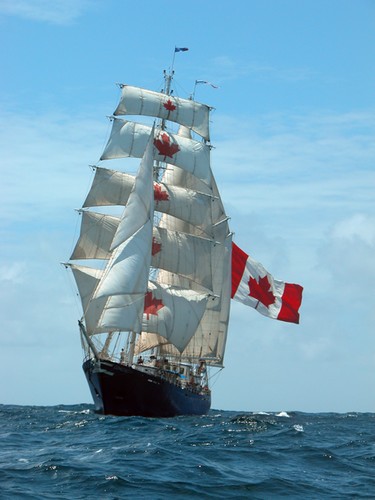Microburst blamed for sinking of tall ship Concordia, all 64 rescued
by Sail-World Cruising on 21 Feb 2010

Concordia - a down draft of wind is claimed by the Captain to have sunk her SW
48 students and the 16 professional crew and teachers from the Concordia, which sank 300 miles off the coast of Brazil, have been rescued successfully. The story of their rescue could be worthy of a scene in a novel, but it's also a good example of well-trained sailors.
The Concordia is a Canadian floating classroom which has taken over 1000 GAP and university students, who have earned both high school and university credits while sailing around the world.
The Concordia's Captain William Curry told the Associated Press on Saturday that the his tall ship sank Wednesday afternoon - a day earlier than previously reported. All 64 people aboard were rescued by merchant ships early Friday.
Curry said he and the Concordia's crew had prepared a day beforehand for what they anticipated would be rough but not unusual weather. He was below deck when the ship suddenly keeled over and then recovered. It was when it keeled a second time that he knew the vessel was in danger.
Curry blamed the sinking of his vessel on a 'microburst,' a sudden, vertical downdraft.
When the vessel keeled over, the entire surface area of the sails was exposed to the powerful wind, and within 15 seconds, the boat went from sailing normally, upright, to lying on its side, the window began to pop and the water pressure and beginning to sink.
Thirty minutes later it was completely underwater, Curry said. The ships radio was submerged in seconds, however her automatic EPIRB fired.
In the dark hours before dawn last Thursday, the captain of the Phillipine flagged merchant ship Hokuetsu Delight was contending with high winds and rough seas when he received notice of a distress signal from tall ship Concordia from the Brazilian coast guard.
Cpt. Edgardo Ybranez set out at 3:50 a.m local time to the last co-ordinates the Concordia had transmitted.
The mission took five hours of navigating through turbulent waters and strong winds by a seasoned crew that grew increasingly anxious as they approached the site of the sunken ship.
'We were worried about finding the survivors, of course,' one unidentified crew member told the Calgary Herald. 'We are seamen, and we were very concerned about finding people, survivors.'
By the time they arrived at the scene, the students and crew had survived for 20 hours in life rafts after they abandoned the sinking Concordia. They were well organised - they had food and water, enough to last days if they needed it, and blankets and tent cover to keep warm.
They spotted the groups several hours after dawn — 44 students and crew in three lifeboats that had been lashed together as the Concordia sank. Some of the students were too exhausted to do anything other than weep with relief at the sight of the cargo vessel, while others were able to cheer along the relieved crew of the Hokuetsu Delight.
By 8:05 a.m., the captain was able to close the chapter in the ship's log: rescue completed, all 44 aboard the Hokuetsu Delight. In the meantime, another merchant ship, a tanker by the name of Crystal Pioneer, had also arrived and collected the remaining 20 crew members.
However, they weren't home yet, and now an attempt was made to transfer the sailors from the merchant ships to a Brazilian naval frigate, the Constituicao, which was one of two that had also been summoned to the scene. The weather was too bad to effect this by water, so helicopter were being used, when worsening weather and gathering darkness shut this effort down as well.
It was decided that the merchant ships would divert and take their rescued guests back to Rio de Janeiro, where they have now arrived. Next come the questions. The Captain of the ship has stated that a 'down draft' of wind caused the sinking of the ship.
The Concordia was a seemingly sturdy, steel-hulled tall ship, stretching 188 feet with three masts and 15 sails. It was built in 1992, specifically to become a floating high school. It had set sail on Feb. 8 from Recife on Brazil’s northwest coast bound for Montevideo, Uruguay, with a mix of mostly Canadian students continuing on from September and about a dozen who were just starting out on a trip with the Class Afloat program.
'This is the life of a sailor,' one student recounted earlier this month in a post to the web. 'It is tiresome, stressful, difficult and unconventional, but it is fulfilling beyond belief.'
They set out for an adventure while completing their studies, but while the Class Afloat had trained them well so that the abandoning of the ship went like clockwork, this was an adventure they weren't expecting.
Back on land, plans are already made to prepare the rescued sailors with clothes, counselling and get them back home to Canada. The Brazilian ambassador and the Canadian consul-general are helping to co-ordinate the effort.
If you want to link to this article then please use this URL: www.sail-world.com/66633